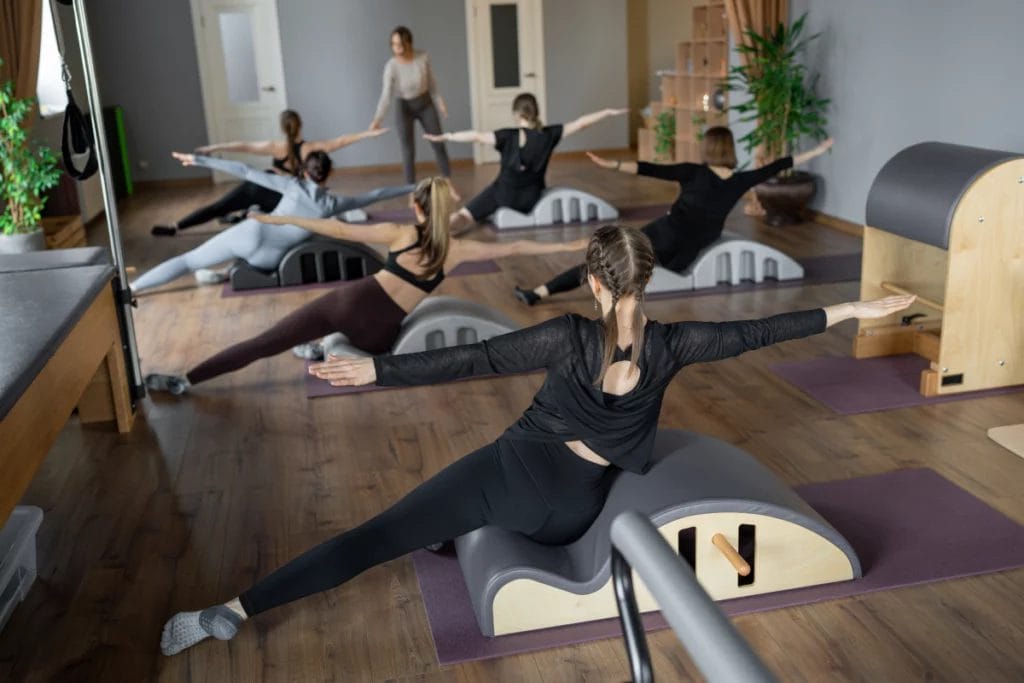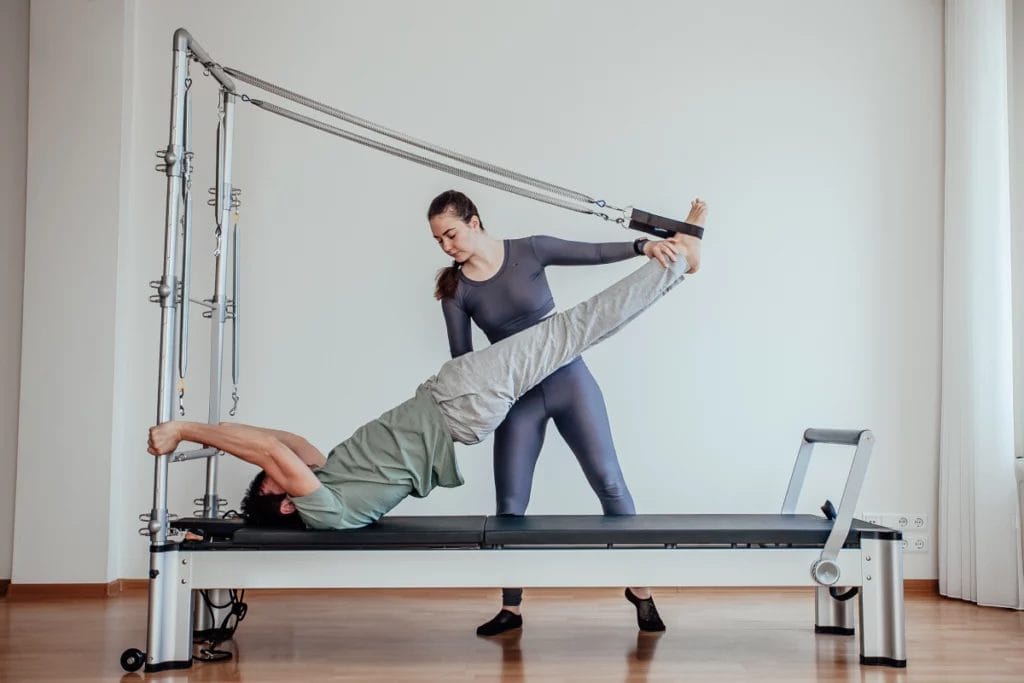You discovered Pilates.
You fell in love with Pilates.
You get certified to teach Pilates.
What could go wrong?
A lot, actually! Recognizing the risks of teaching Pilates is the first step in creating a safe, successful, and lasting career. We’re covering the four most common instructor risks and tips on how to avoid them.
1. Client Injuries and Injury Liability Claims
Pilates is a physically demanding activity, and like any physical activity there’s a risk of getting hurt. It’s a low risk, but it’s never zero.

Client Injuries
Mat Pilates carries many of the same injury risks as other group fitness classes, including muscle strains, sprains, or tendonitis. Reformer and mixed apparatus sessions introduce added risks from equipment use, such as misalignment or pinching.
“Potential risks include falls from the equipment, dizziness from prolonged supine positions, and challenges related to balance and stability. Clients may experience lightheadedness after lying flat for 30+ minutes and then getting up too quickly. There’s also a risk of falling into the Reformer’s well or off the machine during transitions.”
Carlie Snyder, AFAA Certified Personal Trainer and Certified Bender Pilates Reformer Instructor
Falls are also one of the most common causes of liability claims across all fitness styles at Insurance Canopy. Other potential causes of Pilates injuries include:
- Clients overextending themselves
- Clients performing movements incorrectly
- Equipment malfunctions
- Underlying health conditions
Injuries can range from minor cuts and bruises to strains and sprains. In rarer cases, students may experience more severe injuries, like a broken bone. You can reduce the chance of client injuries in your class by:
- Using health history forms to assess participants’ readiness for the demands of Pilates
- Doing skill assessments to ensure machine resistance is at a proper setting and to avoid assigning clients movements they aren’t ready for
- Separating classes by skill or experience level
- Assessing the room and equipment for hazards (like a loose screw or spring) before each class
- Demonstrating the correct way to perform movements
- Providing modifications when needed
In 15 years of Reformer Pilates instruction, Snyder has only had two minor incidents involving falls, neither of which required medical attention. How Snyder protects her clients:
“I provide frequent verbal cues and clear safety warnings throughout sessions. Clients are instructed to sit on the machine briefly before standing to prevent dizziness. I demonstrate all potential fall risks before anyone gets on the equipment and assess each client’s ability prior to assigning exercises to ensure they’re never put in a compromising position.”

Liability Claims
Even when you do everything right, accidents can still happen. If they do, you could be responsible for your student’s medical bills. Urgent care and doctor visits can reach hundreds, thousands, even hundreds of thousands of dollars — money most Pilates instructors don’t have lying around.
Liability claims filed against you aren’t just a risk to your wallet. If an upset client starts talking negatively about you to their friends or on social media, it could harm your reputation. A bad reputation could make it harder to get jobs or book clients.
However, your livelihood is significantly less at risk when you have general liability insurance. Insurance helps pay for injury claims that’d be hard to pay on your own. Plus, the ability to help clients if they do get hurt goes a long way in maintaining positive relationships.

2. Professional Liability and Lawsuits
Pilates instructors also face legal and professional liability risks, like lawsuits and negligence claims.
Professional Liability
Professional liability is the term used for situations that result in injuries or damages caused by your errors, omissions, or negligence. These things typically involve:
- Providing incorrect or incomplete guidance
- Failure to adequately supervise a class or student
- Failure to offer appropriate modifications
- Making a mistake that causes financial harm to another person
Similar to general injury liability claims, claims brought against you for these things could be detrimental to your reputation and finances.
Lawsuits
Injury and negligence claims could also turn into legal battles. Lawsuits are even more expensive than a trip to an urgent care, with the average cost of a lawyer running $200-$400 per hour.
Mitigate the risks of professional liability claims and lawsuits by:
- Requiring liability waivers
- Staying within your scope of practice (aka teaching only what you’re qualified to teach)
- Being attentive in class
- Helping students if they get hurt, but do not admit fault
Further protect yourself in the event of error or negligence claims and lawsuits with professional liability insurance. This coverage helps you pay for claims and court costs. It can also cover your legal defense costs even if you’re not found at fault.
Pro Tip: Some insurance companies sell professional liability insurance separately from general liability. Insurance Canopy includes both professional and general liability in our base Pilates instructor policy.

3. Property Damage
Property damage is another potential risk for Pilates instructors, including things like:
- Accidentally dropping a client’s bag, cracking their smartphone
- Breaking a spring while adjusting the tension on a machine
- A client unintentionally hitting a mirror and damaging it because their setup was too close to the wall
You could be held accountable by your employer or your client for the cost of fixing things like this. A new spring may only cost $30, but a basic iPhone 14 screen costs around $170 to repair.
Pilates apparatuses are also expensive, with a standard Reformer machine retailing over $3,000. Fortunately, Snyder says commercial-grade Reformer equipment is durable and built to last, with maintenance typically limited to spring, screw, or padding replacement.
Reduce the risk of property damage incidents by:
- Checking all equipment before using it
- Making sure machines and people have enough space around them in the classroom
- Making sure clients stow all their personal items in an appropriate, out-of-the-way place
In the event you are faced with physical damage claims, Pilates teacher insurance can pay repair and replacement costs, so you can worry less about property damage price tags.
Pro Tip: General liability insurance covers damage to others’ property, not your equipment. You need gear and equipment insurance to cover any gear that you own and use while teaching.

4. Burnout
Burnout is a real risk for Pilates instructors, yoga teachers, and personal trainers. It’s easy to fall into the trap of always being “on” when you make a living through exercise and fitness.
A lot of instructors also work more than one job, or in more than one location. That takes time and energy on top of what you need for class planning and client scheduling. If you don’t have a system in place to help you manage your work stress, it can lead to burnout.
The consequences of burnout include:
- Feeling negative, overwhelmed, or easily irritated all the time, which makes client interactions harder
- Consistently feeling sluggish and/or sore, which makes teaching more difficult
- Making more mistakes or increased forgetfulness, which increases the risk of client injuries and negligence accusations
- Procrastinating more, dreading anything “work-like,” which makes teaching harder and ups your chances of making a mistake
- Increased risk of injuring yourself
When you’re burnt out it’s harder to do your job. As a result, it’s easier to overlook safety measures, which increases the risk of client injuries and lawsuits.
Burnout can also affect your personal health and well-being. If you don’t get the physical and mental rest that you need, your body may give out, leading to an injury or illness later.
Protect your clients (and yourself) by reducing your risk of burnout.
- Get plenty of sleep, regularly
- Take your own rest days
- Stay hydrated and make sure you’re eating plenty of nutrient-rich foods
- Set boundaries with clients and hold to them (like no calling or texting between certain hours)
- Get affordable Pilates instructor insurance to take the worry over liability claims and lawsuits off your stress list

Common Questions About the Risks Pilates Instructors Face
What Insurance Do Pilates Instructors Need?
Pilates instructors need:
- General liability insurance: For injuries and property damage accidentally done to others.
- Professional liability insurance: For injuries or damages done to others because of negligence or mistakes
- Personal and advertising injury: For accusations of copyright infringement, defamation, or invasion of privacy
- Damage to rented premises coverage: For accidental damage done to rented spaces you use for teaching
- Medical expenses: For smaller injuries and medical bills regardless of fault
How Can I Protect Myself as a Pilates Instructor?
Protect yourself and your business by:
- Getting liability insurance to safeguard your bank account in case of claims or lawsuits
- Following best practices for safety in the studio
- Working within your scope of practice (aka what you’re qualified to do)
- Staying up to date on your relevant certifications (like CPR)
If I Take On More Students, How Does That Affect My Insurance Needs?
The more students you take on, the higher the chances of someone getting hurt or an accident occurring. A $2 million general liability limit is the standard amount of coverage. Insurance Canopy’s limit is higher at $3 million.
If you aren’t satisfied with that amount, you can add an excess liability endorsement to boost that overall coverage amount higher.
Note: Excess liability coverage cannot be added online. You must call and speak with a representative in that case.





